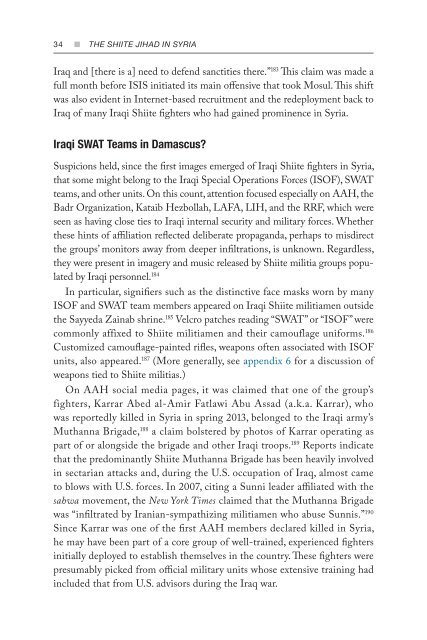Create successful ePaper yourself
Turn your PDF publications into a flip-book with our unique Google optimized e-Paper software.
34 n <strong>THE</strong> <strong>SHIITE</strong> <strong>JIHAD</strong> <strong>IN</strong> <strong>SYRIA</strong><br />
Iraq and [there is a] need to defend sanctities there.” 183 This claim was made a<br />
full month before ISIS initiated its main offensive that took Mosul. This shift<br />
was also evident in Internet-based recruitment and the redeployment back to<br />
Iraq of many Iraqi Shiite fighters who had gained prominence in Syria.<br />
Iraqi SWAT Teams in Damascus?<br />
Suspicions held, since the first images emerged of Iraqi Shiite fighters in Syria,<br />
that some might belong to the Iraqi Special Operations Forces (ISOF), SWAT<br />
teams, and other units. On this count, attention focused especially on AAH, the<br />
Badr Organization, Kataib Hezbollah, LAFA, LIH, and the RRF, which were<br />
seen as having close ties to Iraqi internal security and military forces. Whether<br />
these hints of affiliation reflected deliberate propaganda, perhaps to misdirect<br />
the groups’ monitors away from deeper infiltrations, is unknown. Regardless,<br />
they were present in imagery and music released by Shiite militia groups populated<br />
by Iraqi personnel. 184<br />
In particular, signifiers such as the distinctive face masks worn by many<br />
ISOF and SWAT team members appeared on Iraqi Shiite militiamen outside<br />
the Sayyeda Zainab shrine. 185 Velcro patches reading “SWAT” or “ISOF” were<br />
commonly affixed to Shiite militiamen and their camouflage uniforms. 186<br />
Customized camouflage-painted rifles, weapons often associated with ISOF<br />
units, also appeared. 187 (More generally, see appendix 6 for a discussion of<br />
weapons tied to Shiite militias.)<br />
On AAH social media pages, it was claimed that one of the group’s<br />
fighters, Karrar Abed al-Amir Fatlawi Abu Assad (a.k.a. Karrar), who<br />
was reportedly killed in Syria in spring 2013, belonged to the Iraqi army’s<br />
Muthanna Brigade, 188 a claim bolstered by photos of Karrar operating as<br />
part of or alongside the brigade and other Iraqi troops. 189 Reports indicate<br />
that the predominantly Shiite Muthanna Brigade has been heavily involved<br />
in sectarian attacks and, during the U.S. occupation of Iraq, almost came<br />
to blows with U.S. forces. In 2007, citing a Sunni leader affiliated with the<br />
sahwa movement, the New York Times claimed that the Muthanna Brigade<br />
was “infiltrated by Iranian-sympathizing militiamen who abuse Sunnis.” 190<br />
Since Karrar was one of the first AAH members declared killed in Syria,<br />
he may have been part of a core group of well-trained, experienced fighters<br />
initially deployed to establish themselves in the country. These fighters were<br />
presumably picked from official military units whose extensive training had<br />
included that from U.S. advisors during the Iraq war.


